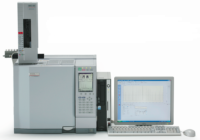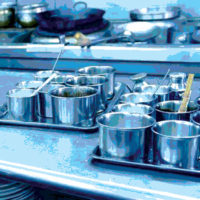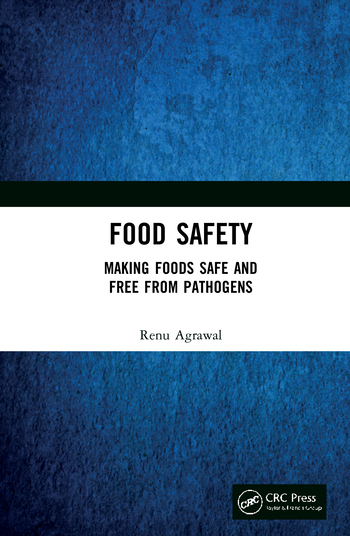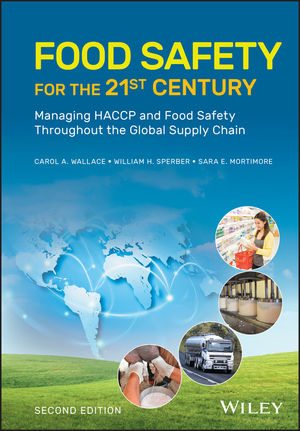Electron Beam Technology: A Platform for Safe, Fresh, and Chemical-Free Food

People deserve safe foods—foods that are safe from chemical, microbial, and physical toxicants. There is an expectation that foods are free of microbial pathogens, insecticides, and chemical preservatives, and are as “fresh” as possible. Consumers are willing to pay a premium for such foods. Food quality is of high value to the food industry, and it is therefore not surprising that companies around the world are investing in technologies that ensure quality and safety.
Electron beam (eBeam) technology is a nonthermal, chemical-free, food processing technology that is slowly and steadily making a profound change in the quality and safety of foods, food ingredients, and food packaging around the world. This article discusses the science, current commercial applications, and potential and emerging applications of this technology in the food and allied industries. This article describes why eBeam technology is not a one-off technology but a platform that has varied applications in the food industry. The technology is already in widespread use in the medical device and pharmaceutical industries, where the sterility of devices and formulations must meet stringent specifications.
.png) To understand eBeam technology, one has to understand the concept of ionizing and nonionizing radiation. Ionizing and nonionizing radiation are part of the electromagnetic spectrum that powers much of our technology. Radiation such as that generated in radio transmission towers, TV towers, microwaves, and UV bulbs is considered nonionizing radiation, because it does not have the energy to ionize the molecules it encounters. On the other hand, radiation emitted from X-ray tubes, eBeam linear accelerators, and radioactive isotopes such as cobalt-60 is much more energetic and can ionize the molecules it encounters. The food industry has a long and successful history with cobalt-60-based technology. Food irradiation is one of the most widely and deeply investigated food processing technologies, with over 100 years of research and development behind it. Irradiation with cobalt-60 is used to disinfect fresh produce, decontaminate spices, and pasteurize foods in the U.S. and in over 50 other countries. In the U.S., irradiation technology for the phytosanitary treatment of selected imported fruits is increasing exponentially (Figure 1).
To understand eBeam technology, one has to understand the concept of ionizing and nonionizing radiation. Ionizing and nonionizing radiation are part of the electromagnetic spectrum that powers much of our technology. Radiation such as that generated in radio transmission towers, TV towers, microwaves, and UV bulbs is considered nonionizing radiation, because it does not have the energy to ionize the molecules it encounters. On the other hand, radiation emitted from X-ray tubes, eBeam linear accelerators, and radioactive isotopes such as cobalt-60 is much more energetic and can ionize the molecules it encounters. The food industry has a long and successful history with cobalt-60-based technology. Food irradiation is one of the most widely and deeply investigated food processing technologies, with over 100 years of research and development behind it. Irradiation with cobalt-60 is used to disinfect fresh produce, decontaminate spices, and pasteurize foods in the U.S. and in over 50 other countries. In the U.S., irradiation technology for the phytosanitary treatment of selected imported fruits is increasing exponentially (Figure 1).
Core Technology
eBeam technology is an example of ionizing radiation technology. However, that is where the similarity with conventional cobalt-60-based food irradiation technologies ends. Figuratively speaking, eBeam technology is the smartphone of today, while cobalt-60 technology is the rotary dial phone of yesteryear. Due to the increasing costs of acquiring, shipping, storing, and replenishing cobalt-60, the inability to switch off the radiation (from the cobalt-60 source), the slower processing throughputs and the security concerns associated with using radioactive isotopes, cobalt-60-based irradiation technology is being replaced by eBeam technology in different applications. The high commercial value of eBeam technology is that it is easier and less expensive to adopt than cobalt-60 and significantly faster. Moreover, eBeam is a switch-on/switch-off technology, which can be customized for different food industry applications. More important yet, there are no security concerns for this technology compared with cobalt-60-based irradiation technology. Another major difference between the two technologies is that in the case of eBeam irradiation, the radiation is made up of electrons, while in cobalt-60, the radiation consists of gamma radiation or photons.[1,2]
Basics of eBeam Technology
 The device that generates eBeam radiation is termed the “accelerator.” In the accelerator, electrons from commercial electricity are accelerated to very high velocities (~ 99.999% of the speed of light), thereby gaining incredible energies of up to 10 million electron volts (MeV). These electrons are then allowed to penetrate the case-ready packages. Figure 2 is a schematic representation of an eBeam technology platform in use on a food production line. Broadly speaking, accelerators are customized according to the energy of the output electrons (in MeV) and the accelerator power (in kW) that will dictate the possible processing throughputs. There are different types of accelerators in terms of their engineering designs and their operating principles.[3,4] Regardless of energy and power, all accelerators perform the basic function of generating a planar stream of high-energy electrons. For the food industry, eBeam technology applications can be broadly categorized into high-energy (5–10 MeV) applications, medium-energy (1–5 MeV), and low-energy (0.1–1 MeV) applications. Each of these applications meets high-value niches in the food industry. The technology is commercially available and can be purchased off the shelf. Table 1 lists the different food industry applications for the low-, medium-, and high-energy accelerators.
The device that generates eBeam radiation is termed the “accelerator.” In the accelerator, electrons from commercial electricity are accelerated to very high velocities (~ 99.999% of the speed of light), thereby gaining incredible energies of up to 10 million electron volts (MeV). These electrons are then allowed to penetrate the case-ready packages. Figure 2 is a schematic representation of an eBeam technology platform in use on a food production line. Broadly speaking, accelerators are customized according to the energy of the output electrons (in MeV) and the accelerator power (in kW) that will dictate the possible processing throughputs. There are different types of accelerators in terms of their engineering designs and their operating principles.[3,4] Regardless of energy and power, all accelerators perform the basic function of generating a planar stream of high-energy electrons. For the food industry, eBeam technology applications can be broadly categorized into high-energy (5–10 MeV) applications, medium-energy (1–5 MeV), and low-energy (0.1–1 MeV) applications. Each of these applications meets high-value niches in the food industry. The technology is commercially available and can be purchased off the shelf. Table 1 lists the different food industry applications for the low-, medium-, and high-energy accelerators.

Underlying Principles of Action of Energetic Electrons
The energetic electrons from the accelerator produce direct and indirect ionization effects. The direct effects occur when the energetic electrons encounter molecules in the food. During such interactions, ionization occurs (the electrons are ejected out of their orbital shells). These ejected electrons (which pick up a portion of the incoming electrons’ energy) cause similar ionization events on adjacent molecules until the electrons’ energy is finally dissipated. The effect of these ionization events depends on the molecules that are impacted. Since DNA is the largest biomolecule in any cell, it is the primary target for ionization events. Ionization of DNA causes numerous double-strand breaks in the DNA (i.e., “shredding” of the DNA molecules), which effectively inactivates the organism. If these organisms are microbial pathogens, these pathogens are inactivated (thereby ensuring food safety). If these targets are spoilage organisms, these spoilage organisms are inactivated (thereby preventing microbial spoilage, allowing for an extended shelf life). The indirect effects occur when the energetic electrons split water molecules. The splitting of water molecules generates a variety of small amounts of highly reactive but extremely short-lived free radicals such as hydroxyl radicals, hydrogen peroxide, hydrogen, hydrated electrons, and hydrated protons. These free radicals in turn cause extensive double-strand breaks in the DNA in the cells that also add to the inactivation of the organisms. It is difficult to quantify the relative damage caused by direct effects versus indirect effects; however, studies have shown that if the food is frozen, the vast majority of the damage is due to direct effects. Under frozen conditions, the free radicals formed can’t diffuse to neighboring molecules. All of this happens without any increase in the temperature of the target foods. Hence, eBeam processing is termed a nonthermal food processing technology.
D-10 Values, Log Reduction, and Nutrients
Dose is the amount of energy (measured in kilograys, kGy) that is applied to the target food for the specific application. The dose that is delivered to foods depends on the specific application and on the expected resistance of the target pathogen or spoilage organisms. The D-10 value is the dose required to achieve a 1-log reduction (90% reduction). A representative list of the D-10 values of different foodborne pathogens in different food matrices is available from the authors upon request. To achieve any desired log reduction, the eBeam dose used in commercial processing is calculated by multiplying the D-10 value by the required log reduction. Therefore, the technology is tunable to deliver any dose to achieve the necessary log reduction. The commercially used dose is optimized to achieve pathogen kill without changing any sensory or organoleptic characteristics of the food. Larger targets require a lower dose and therefore it takes less energy to inactivate bacterial pathogens as compared with viral pathogens. Damage to proteins and nutrients (including most vitamins) occurs at significantly higher doses than those used to achieve a 6-log reduction of key bacterial foodborne pathogens.
Unlike a traditional cobalt-60-based gamma process, eBeam technology is not an oxidization process. Because there is a large input of electrons with each dose, the process is more reduction than oxidation. Many of the oxidation effects observed with gamma irradiation are not applicable to eBeam processing. Moreover, since the eBeam process occurs much more rapidly than gamma irradiation does, the chances of sensory changes occurring in foods are also significantly lower. This difference in the process dwell time also adds to the positive features of eBeam processing. The sensitivity of the different nutrients also depends on the physical state (frozen or refrigerated) of the food. In a study evaluating the use of eBeam technology for pasteurization of raw milk, our lab demonstrated that even though vitamin B2 content decreased around 32 percent, the B2 content in the eBeam-pasteurized milk met all U.S. Department of Agriculture (USDA) nutritional guidelines. Furthermore, gas chromatographic olfactory analysis indicated that the eBeam process did not result in the development of off odors.[5] These results imply that one cannot assume that the effects on nutrients are the same irrespective of whether eBeam or gamma technology is used.
Regulatory Framework for eBeam Technology Applications
 The U.S. Food and Drug Administration (FDA), USDA, European Union (EU), Brazil, China, India, and the Codex Alimentarius Commission consider eBeam technology equivalent to cobalt-60-based technology. In the United States, FDA has specified the eBeam doses at which specific foods can be processed for either pathogen control, microbial decontamination of spices, extension of shelf life, or phytosanitary treatment of fresh produce (Table 2).[6] The technology can be specifically used for pasteurizing foods at high risk for pathogens such as meats, oysters, spinach, and lettuce. The primary difference between the U.S. regulations and, for example, the regulations in China and India, is that in the U.S., the technology is not allowed for cooked foods. Except for iceberg lettuce and spinach, eBeam technology is not permitted in the U.S. at pasteurization doses for fresh produce. In China and India, however, the technology is being used for cooked foods and fresh produce. Labeling requirements in the U.S. are quite different from what is required in the EU. Contrary to popular belief, the EU has approved the use of eBeam technology and other irradiation technologies for food processing. Although the primary focus of the application of this technology is for spices and food ingredients, poultry and other meat products are routinely pasteurized in the EU with eBeam technology. The volume of food irradiated in the EU is, however, significantly lower than the volume in the U.S.
The U.S. Food and Drug Administration (FDA), USDA, European Union (EU), Brazil, China, India, and the Codex Alimentarius Commission consider eBeam technology equivalent to cobalt-60-based technology. In the United States, FDA has specified the eBeam doses at which specific foods can be processed for either pathogen control, microbial decontamination of spices, extension of shelf life, or phytosanitary treatment of fresh produce (Table 2).[6] The technology can be specifically used for pasteurizing foods at high risk for pathogens such as meats, oysters, spinach, and lettuce. The primary difference between the U.S. regulations and, for example, the regulations in China and India, is that in the U.S., the technology is not allowed for cooked foods. Except for iceberg lettuce and spinach, eBeam technology is not permitted in the U.S. at pasteurization doses for fresh produce. In China and India, however, the technology is being used for cooked foods and fresh produce. Labeling requirements in the U.S. are quite different from what is required in the EU. Contrary to popular belief, the EU has approved the use of eBeam technology and other irradiation technologies for food processing. Although the primary focus of the application of this technology is for spices and food ingredients, poultry and other meat products are routinely pasteurized in the EU with eBeam technology. The volume of food irradiated in the EU is, however, significantly lower than the volume in the U.S.
Food Safety Applications
A number of papers report on the ability of eBeam processing to achieve significant reductions of microbial pathogens on a variety of foods.[7–10] There is no question regarding the efficacy of this technology. Commercial adoption of the technology by the retail food industry has been slow. However, the number of U.S. retailers using this technology for food safety applications is slowly increasing. For example, eBeam-irradiated ground beef is available from Schwan’s and Wegmans. What decision makers in the industry and especially their legal departments want to know is the cost-benefit metrics of adopting this technology. To this end, studies at the National Center for Electron Beam Research at Texas A&M University are using tools such as quantitative microbial risk assessment to quantify the reduction in potential infection risks when the technology is adopted. Research in our laboratories is generating information to enable food industry professionals to make risk-based decisions about this technology.[7–9]
Ensuring Availability of Chemical-Free Fresh Produce
Demand is increasing worldwide for a year-round supply of exotic fruits and vegetables. However, many countries are very protective of their agriculture due to the risk of accidental importation of agriculturally devastating insects and pests, and therefore regulate the entry and exit of agricultural commodities based on international standards.[11] The technology of choice for many decades has been methyl bromide because of its effectiveness against insects, including spiders, mites, and nematodes, as well as fungi. However, the production of this chemical is heavily restricted due to its damaging effects on the ozone layer. It is also extremely dangerous in terms of occupational health and accidental exposure.[12] To reduce methyl bromide use, the USDA Animal and Plant Health Inspection Service (APHIS) has been permitting the use of vapor heat, hot water dips, and cold treatments as alternatives. However, most of these treatments impair fruit quality. As an alternative, USDA-APHIS has permitted the use of eBeam processing at phytosanitary/disinfestation doses (0.150–1 kGy). This technology is currently used for imported Mexican and Pakistani mangoes and other exotic fruits from Southeast Asia. The growing adoption of eBeam technology for disinfestation (phytosanitary treatment) by large U.S. retailers such as Walmart is making an impact on how the U.S. retail industry is adopting the technology.
This emerging high-value application is noteworthy from different perspectives. First, the ability to replace methyl bromide with a chemical-free technology such as eBeam will significantly reduce global use of methyl bromide. Methyl bromide use around the world is regulated by a number of international treaties such as the Montreal and Kyoto protocols. Since 2005, the production and use of methyl bromide has been stopped except for critical uses such as phytosanitary treatments. Therefore, having a methyl bromide alternative such as eBeam processing is of extremely high value to the U.S. and other countries. The commercially available eBeam technology can empower a number of nations around the world that were unable to export to large markets due to the lack of suitable phytosanitary treatment technologies. Second, the ability to reduce or eliminate methyl bromide use will have a significant effect on the occupational health of farmworkers involved in the processing and packaging of fruits for export. Third, technologies such as hot water dips (for mangoes especially) have a deleterious effect on their quality, because to withstand the hot water dip, the mangoes have to be harvested at a lower Brix level. This is in stark contrast to mangoes that can be harvested with a higher Brix content because the eBeam processing can be performed on riper fruits. This simple difference in the Brix content has a significant difference in the quality of the fruits. Unpublished data suggest that mangoes treated with eBeam doses can be stored for months under refrigerated conditions (without a perceptible loss in quality) compared with the hot-water-treated mangoes. This ability to extend the shelf life of mangoes has major ramifications in terms of reducing the shelf life losses, which in turn can reduce food waste. Therefore, it is evident how the use of eBeam technology to replace a chemical such as methyl bromide is of high value at both the macro- and microeconomic levels.
Eliminating Hydrogen Peroxide and Energy Savings during Aseptic Food Packaging
 Aseptic packaging has been around in the food industry for about 70 years; in the U.S., the industry is estimated to be approximately a $3.5 billion business. The pivotal driver for this technology was FDA approval in 1981 of hydrogen peroxide as the sterilizing agent for the packaging material that comes into contact with the food in question. Today, there are over 500 commercial aseptic packaging systems and they all involve hydrogen peroxide. Low-energy eBeam technology is an ideal replacement for hydrogen peroxide. With eBeam sterilization of the packaging material, there is no need to use hydrogen peroxide, nor is there any need for heat to dissipate the hydrogen peroxide. Moreover, from an occupational standpoint, the workers are not exposed to this toxic chemical. The use of a low-energy eBeam-generating device allows this technology to be integrated in-line into the aseptic process line (Figure 3). There is now a commercially offered aseptic packaging system with an integrated eBeam sterilizing system. According to company estimates, there has been 80 percent less energy consumption for sterilization, a 40 percent reduction in the carbon dioxide footprint, and 33 percent less electrical power consumption. These savings are of high value to a commercial entity that puts a premium on reducing chemicals in foods, reducing the carbon footprint, ensuring sustainable practices, and improving worker safety.
Aseptic packaging has been around in the food industry for about 70 years; in the U.S., the industry is estimated to be approximately a $3.5 billion business. The pivotal driver for this technology was FDA approval in 1981 of hydrogen peroxide as the sterilizing agent for the packaging material that comes into contact with the food in question. Today, there are over 500 commercial aseptic packaging systems and they all involve hydrogen peroxide. Low-energy eBeam technology is an ideal replacement for hydrogen peroxide. With eBeam sterilization of the packaging material, there is no need to use hydrogen peroxide, nor is there any need for heat to dissipate the hydrogen peroxide. Moreover, from an occupational standpoint, the workers are not exposed to this toxic chemical. The use of a low-energy eBeam-generating device allows this technology to be integrated in-line into the aseptic process line (Figure 3). There is now a commercially offered aseptic packaging system with an integrated eBeam sterilizing system. According to company estimates, there has been 80 percent less energy consumption for sterilization, a 40 percent reduction in the carbon dioxide footprint, and 33 percent less electrical power consumption. These savings are of high value to a commercial entity that puts a premium on reducing chemicals in foods, reducing the carbon footprint, ensuring sustainable practices, and improving worker safety.
The Myth of Consumer Resistance to eBeam and Other Irradiation Technologies
There are anecdotes that consumers are resistant to accepting irradiated (eBeam or gamma) foods in the marketplace. The word “irradiation” and the Radura symbol are supposedly problematic to the consumers. However, empirical data on the growing volumes of irradiated fresh produce in the U.S. market over the last 5 years reflect the opposite (Figure 1). Studies reveal that consumers are willing to pay an additional 5–25 cents per pound for microbiologically safe ground beef.[13] Not one irradiated food item has been recalled from the market due to consumer concerns. Importantly, studies show that scientifically valid information on the technology and the benefits of eBeam irradiation can make a profound change in consumers’ perception of the technology and a willingness to purchase an eBeam-irradiated food item.[14] Today, irradiated raw oysters, spices, ground beef, mangoes, and guavas are widely available in the U.S. The growing availability of such items in retail markets in the U.S. is a testimony to the growing adoption of the technology by the industry and growing consumer willingness to purchase irradiated foods.
In closing, eBeam technology is a platform technology that has a number of applications in the food industry. The capital costs of eBeam systems are decreasing because of the advances in the technology and the growing use of eBeam technology in different industries. It behooves the decision makers in the food industry to get a deep understanding of this technology so that it can be harnessed to eliminate microbial pathogens, extend the shelf life of foods or expand the export/import of fresh fruits and vegetables, as well as meat products.
Suresh D. Pillai, Ph.D., is the director of the National Center for Electron Beam Research. He brings together researchers from across the Texas A&M University System and around the world to harness their skills to make paradigm-shifting changes in how we address contemporary food, public-health and environmental challenges. He is a molecular microbiologist by training and has been with the Texas A&M University System for over 25 years. His research program focuses on molecular microbiology as it relates to food processing, food safety and environmental microbiology. In addition, his research focuses on the detection, characterization, and decontamination of microbial populations in natural and man-made ecosystems using a variety of contemporary tools such as genomics, transcriptomics, proteomics, and metabolomics.
Sohini S. Bhatia is a graduate researcher at the National Center for Electron Beam Research at Texas A&M University. As a microbiologist, her research has focused on the effects of high-energy electron beam irradiation on stress responses of enteric bacteria. Her current focus is the use of high-energy electron beam irradiation for veterinary vaccine development. The National Center for Electron Beam Research, an IAEA Collaborating Centre for Electron Beam Technology for Food, Health and Environmental Applications, is the leading academic and research organization in the world focused on the research, development, and commercialization of electron beam technologies.
References
1. Miller, RB. Electronic Irradiation of Foods: An Introduction to the Technology (New York: Springer, 2005), p. 350.
2. Pillai, SD and S Shayanfar. Electron Beam Pasteurization and Complementary Food Processing Technologies (UK: Elsevier, 2015), p. 324.
3. Cleland, MR. “Electron Beam Materials Irradiators.” In Industrial Accelerators and Their Applications, eds. RW Hamm and ME Hamm (Singapore: World Scientific Publishing Company, Pte. Ltd., 2012).
4. Pillai, SD. 2016. “Introduction to Electron-Beam Food Irradiation.” Chem Eng Prog Mag November.
5. Ward, LR et al. 2017. “Nutrient Profiles and Volatile Odorous Compounds of Raw Milk after Exposure to Electron Beam Processing Doses.” J Food Sci 82:1614–1621.
6. FDA. “Irradiation in the Production, Processing and Handling of Food.” C.F.R. Title 21 Part 179.
7. Espinosa, AC et al. 2012. “Quantifying the Reduction in Potential Health Risks by Determining the Sensitivity of Poliovirus Type 1 Chat Strain and Rotavirus SA-11 to Electron Beam Irradiation of Iceberg Lettuce and Spinach.” Appl Environ Microbiol 78:988–993.
8. Praveen, C et al. 2013. “Susceptibility of Murine Norovirus and Hepatitis A Virus to Electron Beam Irradiation in Oysters and Quantifying the Reduction in Potential Infection Risks.” Appl Environ Microbiol 79:3796–3801.
9. Shayanfar, S et al. 2016. “Quantifying the Reduction in Potential Infection Risks from Non-O157 Shiga Toxin Producing E. coli in Strawberries by Low Dose Electron Beam Processing.” Food Contr 72:324–327.
10. Palekar, MP et al. 2015. “Reduction of Salmonella enterica Serotype Poona and Background Microbiota on Fresh-Cut Cantaloupe by Electron Beam Irradiation.” Int J Food Micro 202:66–72.
11. Pillai, SD et al. “Applications of Ionizing Irradiation for Phytosanitary Treatment and Food Safety for Fresh Produce.” In Global Safety of Fresh Produce: A Handbook of Best-Practice Examples, Innovative Commercial Solutions and Case Studies, ed. J Hoorfar (Oxford, UK: Woodhead Publishing, 2014).
12. www.thedailybeast.com/the-bug-spray-that-felled-a-family.
13. Nayga, RM. 2003. “Will Consumers Accept Irradiated Food Products?” Intl J Consumer Stud 27:220.
14. Nayga, RM et al. 2006. “Willingness to Pay for Reduced Risk of Foodborne Illness: A Nonhypothetical Field Experiment.” Can J Agr Econ 54:461–475.
Looking for a reprint of this article?
From high-res PDFs to custom plaques, order your copy today!









